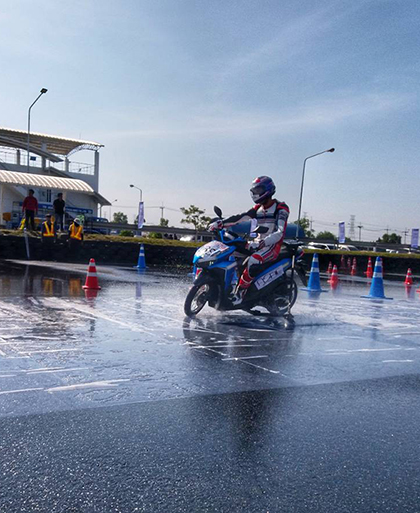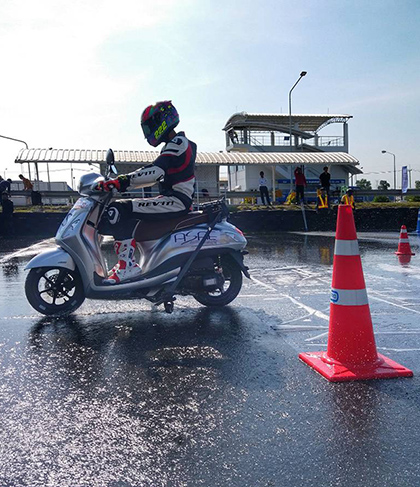 Thailand – The FIM – Fédération Internationale de Motocyclisme on their visit to the TTK Asia test facility says that a Combined Brake System (CBS) for small motorcycles is not good enough compared to ABS (Antilock Braking System) in an emergency stop.
Thailand – The FIM – Fédération Internationale de Motocyclisme on their visit to the TTK Asia test facility says that a Combined Brake System (CBS) for small motorcycles is not good enough compared to ABS (Antilock Braking System) in an emergency stop.
FIM said this after the TTK ASIA Test facility was visited on the 18th December 2018 by FIM Asia President Stefan Carapiet, FIM Director of Public Affairs John Chatterton-Ross, and Thongchai Wongsawan, President of FMSCT (Federation of Motor Sport Clubs if Thailand) Thailand.
What the FIM said in full was that, “Combined braking systems (the rider operates one brake lever or pedal but the system activates both brakes) are claimed by some in the motorcycle industry to be good enough for small motorcycles in an emergency.” with the tests at the TTK Asia test facility proving the opposite and that, “Only anti-lock braking (ABS) can prevent wheel locking and loss of control in an emergency stop.”
Tests in Thailand show CBS is no replacement for ABS on small motorcycles – FIM Report
Testing consisted of emergency stops on motorcycles with no ABS or CBS, one with CBS, and one with ABS – although only on the front wheel, as is the case with many ABS motorcycles marketed in the region.
The first tests were done on dry tarmac. Three riders took part, one professional and two Thai citizens, who are motorcyclists, but not professional riders.
Final tests were conducted on a wet track – first wet tarmac and finally tarmac covered in plastic sheeting – also soaked with water to produce the most slippery conditions possible. These demonstrated that even a professional rider has no chance of controlling wheel lock without the help of ABS technology.
The wet surface tests were judged too risky for the regular riders and were demonstrated only by the professional.
The demonstration of ABS effectiveness was backed by the Royal Thai government and a number of sponsors including the Safer Roads Foundation. The event was organised under the leadership of Dr Saiprasit Koetniyom and Dr Wiwat Seetamanotch.
Deputy Transport Minister Teerapong Rodprasert, representing the Royal Thai government, called for urgent action in Thailand and the South East Asia region to cut the number of deaths and serious injuries that occur every day.
Debate European Slant
After the tests delegates and representatives of the media held a lively discussion. John Chatterton-Ross explained that it was only in 2016 that the European Union finally passed regulations on ABS braking for new motorcycles. These contain a provision for the 125cc category to be fitted with CBS instead and the motorcycle industry has latched onto this.
He stated, “This exception was granted by legislators in Brussels when the planning was done years ago. It was claimed by industry that the cost of ABS would wipe out the 125cc sector in the market. This is not the case. Even the lowest cost 125cc scooters in Europe such as the Yamaha NMAX come with ABS.
I remind you that has ABS front and rear with a two-channel system. The motorcycle used in the test today has a lower cost single channel system to the front wheel only. This is a global industry with production costs matched to all different markets.
If the small category CBS option is not needed in Europe it is not needed here in Asia either. It defies logic to design and develop CBS for small machines when off the shelf ABS units are produced by all the leading component suppliers to the motorcycle industry. Account should also be taken of the market. Here small motorcycles are often below the European A1 125cc category. Engine capacities of 70cc, 90cc and 110cc are common together with machines at 150cc.
All of these motorcycles and scooters can be ridden at speeds above 50kph and all of them require ABS at the very minimum single channel to the front wheel. This will not interfere with existing designs where a cable or rod operated drum brake is fitted to the rear wheel for cost saving.”
Stefan Carapiet added, “Today has been a superb example of leadership in road safety. I congratulate everyone here for their work, and their interest. FIM Asia President is committed to improving road safety in our region which has the highest number of motorcyclists in the world.”
 Motorcycle Minds Comment – It would appear that for Europe the FIM has come down on the side that motorcycles – scooters – under 125cc should be fitted with at least a single channel ABS system.
Motorcycle Minds Comment – It would appear that for Europe the FIM has come down on the side that motorcycles – scooters – under 125cc should be fitted with at least a single channel ABS system.
In 2016 when the European Union introduced the regulation making advanced brake systems (ABS) on two-wheel motorcycles obligatory – the anti-lock brake system for medium and high performance two-wheel motorcycles, but either a combined brake systems or an anti-lock brake system for low performance two-wheel motorcycles was left to the choice of the vehicle manufacturer.
However, the European Commission stated at that time that before the end of 2019, whether to decide to propose extending the mandatory fitting of anti-lock braking systems to categories of smaller motorcycles, after an evaluation and taking into account road accident statistics.
Leading up to the introduction of this regulation in Europe there was debate by ACEM – motorcycle manufacturer representative organisation in Europe – FEMA Federation of European Motorcyclists Associations, the European Commission and others including ourselves over the mandatory fitting of ABS.
Perhaps this time there may not be such debate, although the planned evaluation by the European Commission which is taking into account road accident statistics – whether ABS reduces road accidents or whether ABS changes the outcome of injuries – may encourage further debate.
In 2016 Motorcycle Minds Dr Elaine Hardy conducted a pilot study with the aim to identify specific issues relating to crashes involving motorcycles fitted with ABS.
The report published in 2017 – Effects of Advanced (Anti-lock) Braking Systems (ABS) On Motorcycle Crashes – A Survey of 61 motorcyclists who crashed between 2010 and 2015 – saw riders from Australia, South Africa and Europe participate in a rider survey.
These riders overwhelmingly recognised the risk of injury if they are involved in a crash and thus wore highly protective clothing and helmets.
The typical speed of 32% of the riders was between 41 to 60 kilometres per hour (kph), while 13% indicated that their speed prior to braking was between 61 to 70 kph.
Only four (7%) indicated that their speed was more than 100 kph prior to braking.
In terms of how the speed before braking affected the injury severity, the evidence in this study suggests that the injury outcome appears to be nearly random, or rather it is dependent on circumstances other than speed.
The “Dynamics” report focussed on riders that had crashed, however, what is possibly more relevant in terms of the tests carried out in Thailand, is whether the strength of ABS lies in the preventative role it takes in emergency situations. One last thought on the tests in Thailand, it would have been interesting to see the results from the wet surface tests, if the regular riders had been “fired” down the wet tarmac and the area of tarmac covered in plastic sheeting soaked in water.
But that’s another debate on riders requiring training on the use of ABS in all conditions in order that the system keeps the rider safer.
Original Sources – FIM Public Affairs – Tests in Thailand show CBS is no replacement for ABS on small motorcycles – Effects ABS Motorcycle Crashes


Leave a Reply